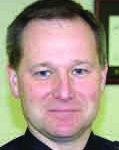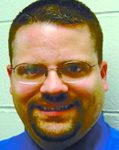Despite the many tips and tools that UW-Whitewater Police Chief Matthew Kiederlen provides students in the event of an active shooter, they must rely on their instincts to ensure their safety.
“It’s one of the things that keeps me up at two o’clock in the morning,” Kiederlen said. “There’s no way to give someone a clear and precise direction as to what to do. There is not—and it’s naïve to think otherwise.”

With recent shootings around the country in the past year, including two in Wisconsin, many institutions are double-checking and updating their emergency procedures. While UW-Whitewater has procedures in place, Kiederlen said that the campus is working toward implementing outdoor speakers, so those outside will be alerted.
As soon as an active shooter is on campus, Kiederlen said students will be sent an emergency alert email. If the shooter is not near the student, the student should stay where they are, and take shelter in a building far away from the location of the shooter.
Before his tenure at UW-Whitewater, Kiederlen was an officer at Northern Illinois University. Shortly after his departure, on Valentine’s Day in 2008, shooter Steven Kazmierczak killed five people and injured 21 before committing suicide. Kiederlen said seeing his former co-workers on the news had a powerful impact on him.
“We talk about a human life having an effect on someone,” he said. “Well, seeing your friends, brothers and sisters go into a situation like that … yeah it has an effect.”
Kiederlen said he carried over many of the policies used at NIU, and he thinks those policies saved lives the day of the shooting.
Associate Director of Residence Life Terry Tumbarello said residence assistants get training by the police every year on what to do in the event of a shooter on campus.
“What we basically tell the staff is if you get any hint of a shooter on campus, you’re to seek shelter in a safe place,” Tumbarello said. “They have no role, nor do I want them to have a role,

beyond that.”
The training the R.A.s receive is a presentation called “Shots Fired,” presented by the police department. Any student can call the police department at 262-472-4660 to schedule the presentation individually or with a group.
Kiederlen said it can take five minutes or an hour and can be presented to one person or one thousand.
“Shots Fired” has a short video, an instruction period and time for questions.
The following are three possible scenarios and what to do if they were to occur.
If you are outside when a shooter is on campus
Kiederlen stated students must make the decision that is right for them, whether that means entering the nearest building and taking shelter or crouching between cars in a parking lot close by.
“The first thing we need people to do is to exercise their own best judgment,” he said. “If you see lots of people in front of you running toward you, I suggest you go in the opposite direction. You have to look at, are you safe where you are? ‘Can I make myself safer?’ ‘What’s my best option right now to where I can be basically sheltered and not in view?’”
If a shooter enters your building
If students know there is an active shooter inside their building, the first step should be to try to escape safely. Whether this means exiting the building through a door or window, students and staff should explore this route first. In the event that escape is possible, cooperate with officers outside and keep hands visible.
If escape is impossible, take shelter in the nearest classroom or office, barricade the door and lock it. Students and staff inside should stay low to the ground inside and keep quiet. If students are in class while a shooter enters their building, they should follow the same instructions. It’s imperative that each student looks out for themselves and does not rely on others to ensure their safety, even professors.
“From a legal aspect, a professor or instructor has no obligation to the students that are in their classroom,” Kiederlen said. “You are adults and that’s exactly how you’re viewed. You might have a professor who acts courageously and brilliantly [in that situation] and you might have one that curls up into a little ball and does nothing.”
If a shooter enters your classroom
In the event that an active shooter enters your classroom, students must use their instincts in order to survive the event.
Playing dead and trying to reason with the shooter are two options. Attacking the shooter should be a last resort and Kiederlen stressed that some people are simply not capable of physically harming someone for their own survival. If the shooter leaves the classroom and escape is possible, do so immediately.
Kiederlen said that his biggest fear in an active shooter scenario is acquiring enough medical assistance. The City of Whitewater has a volunteer fire department and EMT’s. It would be very difficult to get enough medical personnel on the scene, despite how hard the volunteers would work, Kiederlen said.
Tumbarello thinks that the procedures and tools the university has available for students are helpful, but stressed that it’s difficult to prepare for such an unpredictable event.
“I don’t know if I would know if it’s enough unless I was in that situation,” Tumbarello said. “How do you accurately prepare for that type of situation?”
For more information on what to do in the event of an active shooter on campus, visit http://emergency.uww.edu/Guide.aspx?Title=Active_Shooter.

